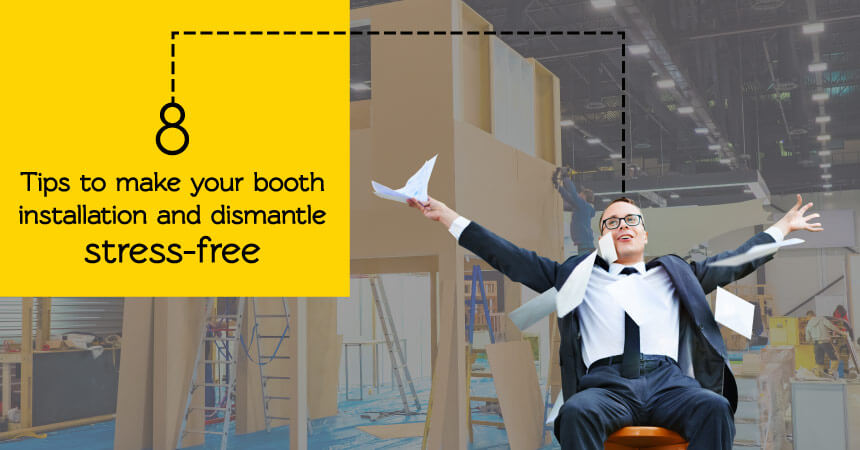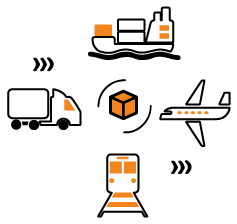
8 Tips To Make Your Booth Installation and Dismantle Stress-Free
The task of setting up your booth on the floor is tedious. It’s stressful to make sure that nothing is missed during setup and nothing was lost during dismantle. But, if you have the right information to use, you can insulate yourself from any last-minute surprises during the installation and dismantle your next trade show booth. But first, let’s lay out the options available for you. You have three options when deciding how to manage your I & D.
First, is the self build option. This option is the most cost-effective but depends on your experience level, the type of booth and its size. Turnkey solutions are available but involve an hour or two of labor at the show floor.
The second option is to hire a local booth contractor to manage it for you. Your contractor is likely to have a more long term relation with I & D companies or have their own team of experts. The benefit of booth contractors is that they offer direct supervision and get the necessary build approval for you. The downside is that it’s often a full package deal, which also includes getting your booth from them.
The third option is to go to a local I & D company directly. These companies have I & D experts who build your trade show booth. You get more experts working on your booth for the same costs, which means you can get set-up quite fast. The downside is that I & D companies have multiple contracts on the day of the show, so you’ll have to manage the supervision for your booth.
So now that you know the difference between going for a self build and partnering up with a booth contractor or I & D company, here are our tips to help you have a stress free I & D management:
1. Send every bit information
Once you’ve selected your partner, it’s important to send them detailed information about your booth and the trade show venue. This includes:
A blueprint and a 3d render of your trade show booth
Completed service orders (materials, electrical, signage, etc) varies based on the trade show and the region you exhibit
A grip base map of the fairgrounds, with your booth space marked
If you are hiring an I&D company, then this will also include installation instructions and a full list of every booth part and its corresponding accessory
2. Ship your booth components in advance
You’ll also have to manage freight and transportation for your booth rental. We recommend you transport your booth components, accessories, and graphics to the trade show, three hours before it starts. If shipping your booth to an advance warehouse is within your budget, then you can start near your venue, days in advance.
3. Keep your I & D partner in the loop about storage
Make sure that you or your I & D partner know where everything is on-hand at the start of the installation. Some booth contractors offer to manage storage for you, but if you plan to set up your own booth, then rent a local storage unit and ship your booth parts at least a week before the show.
4. Label everything and keep lists
Label every component of your booth for easier installation. You and your I & D company will also require set-up diagrams, to ensure that everything matches. Also, have a detailed inventory of which items are being transported and in which boxes.
5. Have multiple copies of every order
If you plan to exhibit alone, then having multiple copies of your service orders, permissions, and installation instructions is a must. You’ll not only need to give these to the show organizers, backup copies come in handy in case of surprise inspections.
 6. Pick an experienced partner
6. Pick an experienced partner
Whether you decide to go with an I & D company or a booth contractor for your trade show booth consider one who has a good reputation for integrity, quality and professionalism. It’s also essential that they have a local presence in the county or city you plan to exhibit.
7. Know what is allowed and what is mandatory
Every city is different and has its exhibiting guidelines. The unions within those cities adjudicate what is permissible. To request a copy from your partner or show organizer and make sure that you read rules before you decide how you want to handle your installation and dismantle.
In some cities, self-build is not allowed, while others have specific safety guidelines that must be followed. This will include fire safety, allowed booth sizes, voltage limit, electrical plugs allowed, flooring, rigging, and use of special equipment such as ladders, lifts and carts.
8. Do a test-run
If it’s possible, then pre-build your trade show booth before packing and sending it to the venue. Several booth contractors offer a pre-build guarantee, where they build your booth at their warehouse and share its pictures with you. This lets you visualize how your booth will look at the trade show.
So, there you have it, 8 tips to make installation and dismantle easier to manage.


